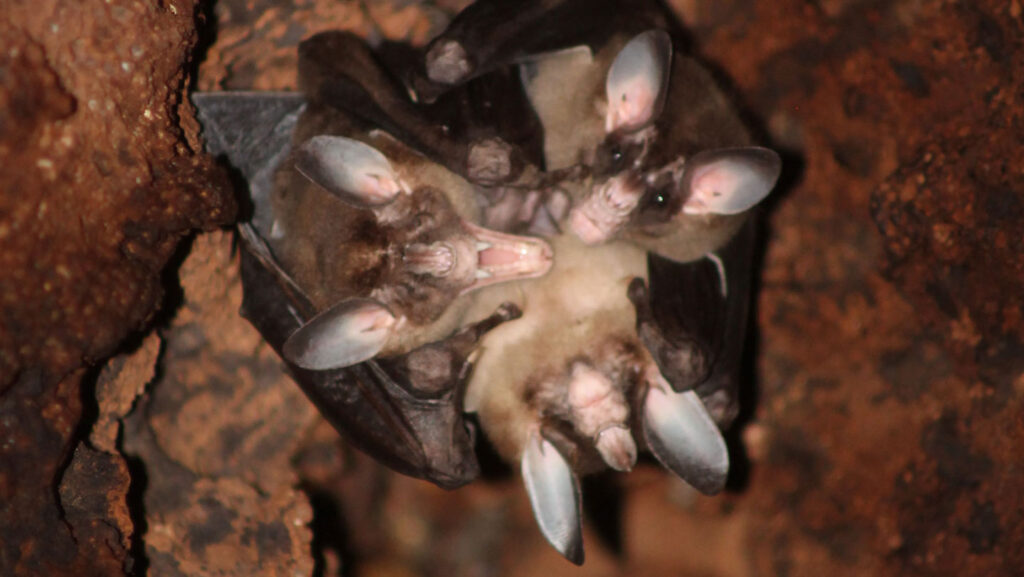Even for the world’s largest carnivorous bat, a hug is the best hello.
Spectral bats are far more cooperative than researchers long assumed, routinely greeting one another with wing wraps and even handing over captured prey to roostmates, researchers report August 20 in PLOS One. Analysis of over 500 videos challenges the notion that spectral bats (Vampyrum spectrum) forage exclusively in solitude.
“What surprised me most was that these apex predators are actually so gentle and curious,” says Marisa Tietge, a behavioral ecologist at Museum für Naturkunde in Berlin. “Hugging seems to be their way of keeping family bonds strong.”
To monitor bat behavior, Tietge and her colleagues placed a motion-sensitive infrared camera inside a hollow Manilkara tree trunk, in Guanacaste, Costa Rica — home to a known roost of four spectral bats. For 60 days spread over three months, the camera recorded one-minute videos upon detecting movement. Among the 502 captured clips, 73 showed the bats exhibiting clear social behaviors, which the team categorized into eight types, ranging from social interactions to play and greeting behavior.
Observations and analysis revealed that the roost — probably a monogamous adult pair and two offspring born in different years — forms tight family bonds through these interactions. In 16 videos, the team saw “social roosting,” where two or more bats nestled in close body contact, wrapping their wings around each other to form a “cuddle ball,” frequently grooming each other. The bats slept this way as well — wrapped in each other’s wings, snouts touching.
The hugging interaction, captured in four videos, stands out as a “very endearing behavior,” says study coauthor Mirjam Knörnschild, an evolutionary ethologist also at Museum für Naturkunde. A bat already in the roost would approach one that had returned, wrapping its wings around them for several seconds, often accompanied by low-intensity vocalizations.
“Hugging seems to be their way of keeping family bonds strong,” Tietge says. “When imagining what could be going on in their head, I’d suggest the sense of familiarity and perhaps even joy might play a role, although this can only be speculated since emotions are very difficult to scientifically prove.”
Tietge says that this greeting behavior may reflect comfort or reassurance, helping to maintain strong social ties. Since both parents invest significant time and resources in raising their offspring, maintaining close social connections is crucial for cooperation and group cohesion, she says.
Alongside these gregarious behaviors, the footage revealed another cooperative act: food provisioning. Captured in about 12 videos, when a bat returned to the roost with prey in its mouth, it often voluntarily relinquished the catch to a younger bat that approached it. A technique for estimating animal body size from video stills confirmed that the bats that brought the food were larger, suggesting parents feeding a pup. This food sharing might help the offspring handle the prey and support their diet transition from milk to meat, the team suggests.
Neuroecologist Yossi Yovel, who was not involved in the study, says bats are cryptic and hard to observe, leaving us unaware of their everyday behavior. “Although the sample size is small, every new observation of bats’ social behavior is valuable,” says Yovel, of Tel Aviv University. “This paper provides a rare example of food provisioning in bats, with some evidence of biparental care of offspring and some evidence of group foraging.”
Animal behavioralist Gerald Carter of Princeton University says, “We might just be scratching the surface of the social complexity in this species,” noting that spectral bats live in monogamous family groups, which is rare among mammals.
“These fascinating behaviors might serve multiple functions,” Carter says. “Most of what we interpret about animal social life is speculative and hypothetical. As the evidence grows, so does our certainty.”
Read the full article here


